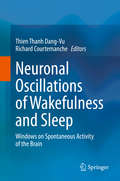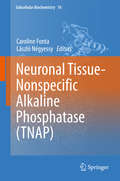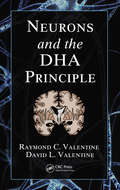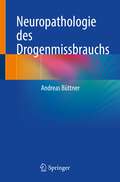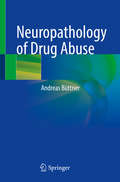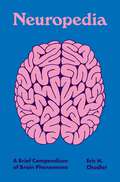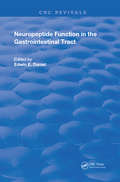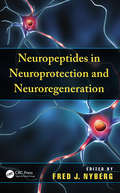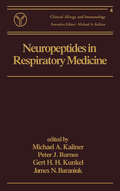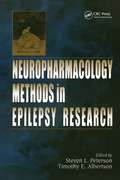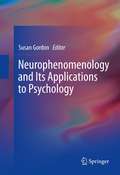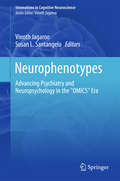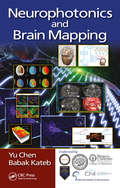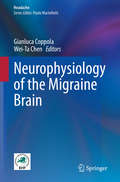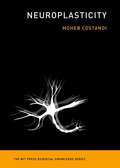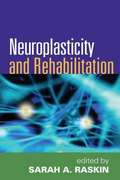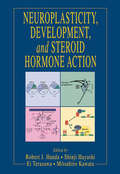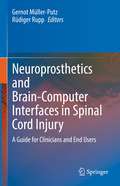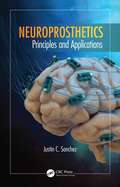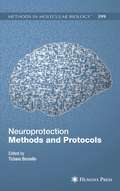- Table View
- List View
Neuronal Oscillations of Wakefulness and Sleep: Windows on Spontaneous Activity of the Brain
by Thien Thanh Dang-Vu Richard CourtemancheThe purpose of this work is to review recent findings highlighting the mechanisms and functions of the neuronal oscillations that structure brain activity across the sleep-wake cycle. An increasing number of studies conducted in humans and animals, and using a variety of techniques ranging from intracellular recording to functional neuroimaging, has provided important insight into the mechanisms and functional properties of these brain rhythms. Studies of these rhythms are fundamental not only for basic neuroscience, but also for clinical neuroscience. At the basic science level, neuronal oscillations shape the interactions between different areas of the brain and profoundly impact neural responses to the environment, thereby mediating the processing of information in the brain. At the clinical level, brain oscillations are affected in numerous neurological conditions and might provide useful biomarkers that inform about patients’ evolution and vulnerability. During sleep, these brain rhythms could provide functional support to internal states that govern the basic maintenance of local circuit and systemic interactions. During wake, the rhythmicity of cortical and subcortical circuits have been linked with sensory processing, cognitive operations, and preparation for action. This book will attempt to link together these sleep and wake functional roles at the level of neuroimaging and electroencephalographic measures, local field potentials, and even at the cellular level.
Neuronal Tissue-Nonspecific Alkaline Phosphatase (TNAP)
by Caroline Fonta László NégyessyPhosphatases, such as TNAP are fundamental in regulating the roles of cellular, and consequently numerous body functions. TNAP is a ubiquitous enzyme with a wide spectrum of substrates and specificity. Regulation at the cellular level and the lack of TNAP activity is a lethal condition. Recent findings of a highly specific regional, laminar and subcellular localization of TNAP in the cerebral cortex indicates that in addition to its metabolic and skeletal functions, TNAP also plays a role in regulating cerebral functions, most probably cognition. In fact, TNAP disturbance could result in complex diseases such as epilepsy, developmental retardation and Alzheimer's disease. Available data suggest that, regarding brain functions, TNAP is a potentially important target of clinical research. This book aims to provide an overview of our current understanding of the functions of TNAP in the brain and on other tissues and organs.
Neuronale Modellierung der Sprachverarbeitung und des Sprachlernens: Eine Einführung
by Bernd J. KrögerDieses Buch erläutert die Thematik der Produktion und Wahrnehmung gesprochener Sprache aus neurowissenschaftlicher Sicht. Nach der Darstellung der Grundlagen der Sprachverarbeitung und des Spracherwerbs wird dem Leser ein neurobiologisch basiertes und computerimplementiertes neuronales Simulationsmodell vorgestellt. Diese Einführung in die quantitative und computerimplementierbare Modellierung der Sprachverarbeitung und des Sprachlernens basiert auf einem naturwissenschaftlich orientierten Ansatz zur Beschreibung gesprochener Sprache. Dennoch wird weitgehend auf mathematische Beschreibungen verzichtet.Das Buch spricht Studierende und Wissenschaftler der Bereiche Neurowissenschaften, Informatik, Medizin, Psychologie und Linguistik an, die sich in das Gebiet der Sprachverarbeitung und des Spracherwerbs aus neurowissenschaftlicher Sicht einarbeiten möchten. Es richtet sich aber auch an Anwender, die sich mit der Entwicklung von Software zur Sprachverarbeitung befassen.
Neurons and the DHA Principle
by Raymond C. Valentine David L. ValentineStudies with bacteria and other systems suggest that the omega-3 fatty acid DHA confers great benefits to neurons in maximizing both speed of neural impulses and energy efficiency. Unfortunately, studies also show that DHA's ease of oxidation damages membrane integrity. Exploring this duality, Neurons and the DHA Principle proposes a new model for
Neuropathologie des Drogenmissbrauchs
by Andreas BüttnerDieses Buch bietet einen umfassenden Überblick über den aktuellen Wissensstand zu Neuropathologien infolge von Drogenmissbrauch. In den ersten Kapiteln erhält der Leser detaillierte Informationen über die neurobiologischen Grundlagen des Drogenmissbrauchs und die Ergebnisse von Neuroimaging-Studien bei Drogenabhängigen. Der Schwerpunkt des Werks liegt auf neuropathologischen Befunden bei Drogenabhängigen für die vorherrschenden Substanzen, zu denen Cannabis, Opiate, Kokain, Amphetamin, Methamphetamin und ein breites Spektrum von Designerdrogen gehören. Diese Befunde werden durch histologische Abbildungen untermauert und im Zusammenhang mit aktuellen wissenschaftlichen Veröffentlichungen diskutiert. Das Buch enthält auch ein Kapitel, das sich speziell an Kliniker richtet und die Auswirkungen auf die weitere Therapie aufzeigt. Eine unverzichtbare Lektüre für Neuropathologen, Neurologen, Neuroradiologen und Psychiater sowie für andere Angehörige der Gesundheitsberufe und Wissenschaftler, die sich für das Problem des Drogenmissbrauchs interessieren und engagieren.
Neuropathology of Drug Abuse
by Andreas BüttnerThis book provides a comprehensive overview of the current state of knowledge concerning neuropathologies resulting from drug abuse. The first chapters offer readers detailed information on the neurobiological basics of drug abuse and the results of neuroimaging studies in drug abusers. The focus of the book is on neuropathological findings in drug abusers for the predominant substances, which include cannabis, opiates, cocaine, amphetamine, methamphetamine and a broad spectrum of designer drugs. These findings are supported by histological illustrations and discussed in connection with recent scientific publications. A chapter specifically addressing clinicians is also included, and highlights the implications for further therapy. The book is essential reading for neuropathologists, neurologists, neuroradiologists and psychiatrists, as well as other health professionals and scientists interested and engaged in the problem of drug abuse. Although a great deal of data has been derived from animal models and from human neuroimaging studies, little is known about the morphological effects of drug abuse on the human brain. In recent years, fundamental drug-induced effects on the cellular elements of the brain have been detected. These alterations might not only be the substrate of the neuroimaging data but might also have implications for clinical research and therapy. In addition, drug abuse may induce premature neurodegeneration.
Neuropedia: A Brief Compendium of Brain Phenomena (Pedia Books #12)
by Eric H. ChudlerA fun and fact-filled A–Z treasury for anyone with a head on their shouldersNeuropedia journeys into the mysteries and marvels of the three pounds of tissue between your ears—the brain. Eric Chudler takes you on a breathtaking tour of the nervous system with dozens of entries that explore the structure and function of the brain and cover topics such as the spinal cord and nerve cells, the methods of neuroscientific research, and the visionary scientists who have dedicated their lives to understanding what makes each of us who we are.The brain has fascinated and puzzled researchers, physicians, and philosophers for thousands of years and captivated us with each new discovery. This compendium of neuroscientific wonders is brimming with facts and insights, helping us to make sense of our current understanding of the nervous system while identifying the frontiers in our knowledge that remain unexplored. Chudler guides readers through a variety of rare and common neurological disorders such as alien hand disorder, Capgras syndrome, Alzheimer’s disease, Parkinson’s disease, and stroke, and discusses the latest brain-imaging methods used to diagnose them. He discusses neurochemicals, neurotoxins, and lifesaving drugs, and offers bold perspectives on human consciousness that enable us to better appreciate our place in nature.With marvelous illustrations by Kelly Chudler, Neuropedia is an informative and entertaining trip into the inner world of the brain.
Neuropeptide Function in the Gastrointestinal Tract (Routledge Revivals)
by Edwin E. DanielFirst published in 1991: This book assimilates and evaluates the rapidly accumulating information regarding neuropeptides in the gut, their chemistry; genetic control; processing in enteric nerves; the projections of their nerves; their actions at the tissue, cell, and molecular levels; and their roles in controlling gut motility in health and disease. Neuropeptide Function in the Gastrointestinal Tract is directed to scientists in all disciplines who work with neuropeptides, as well as physiologists interested in the neural and smooth muscle actions of neuropeptides.
Neuropeptide Techniques
by Illana GozesNeuropeptides exhibit multiple functions as hormones and regulators. As such, many techniques are required to understand the contribution and functions of neuropeptides in health and disease processes. Research in the neuropeptide field is aimed toward a better understanding of the physiology of the human body and toward the development of better diagnostics and therapeutics. This book will familiarize the audience with forefront techniques in the field.
Neuropeptides in Neuroprotection and Neuroregeneration
by Fred J. NybergAlthough the genomic era is no longer in its infancy, the life sciences are still facing questions about the role of endogenous proteins and peptides in homeostasis and pathologies. Delving into one of the most current fields of interest in biology and medicine, Neuropeptides in Neuroprotection and Neuroregeneration describes the impact of neuropep
Neuropeptides in Respiratory Medicine (Clinical Allergy And Immunology Ser. #4)
by Peter J. Barnes James N. Baraniuk Michael A. Kaliner Gert H. H. Kunkel""This outstanding resource offers comprehensive presentations of the latest basic knowledge and the most advanced research on neuropeptides of the respiratory tract covering the structure, receptors, molecular biology, and function of each important neuropeptide and examining how they relate to disease. Demonstrates the utility of immunohistochemistry, autoradiography, molecular biology, smooth muscle contraction, and glandular secretion for the study of neural function both in vitro and in vivo!
Neuropharmacology Methods in Epilepsy Research
by Timothy E. Albertson Steven L PetersonThere is an estimated 2.5 million epileptics in the US and perhaps some 40 million worldwide. As research has become increasingly molecular in scope, fewer scientists are trained in the US on basic, integrated epilepsy techniques. One frustration in neuroscience today is the application of state-of-the-art molecular biology techniques to inappropriate animal models of epilepsy - frequently resulting in inconclusive results. Epilepsy research will be increasingly undertaken by scientists well-trained in reductionist methodology, but who may be unfamiliar with integrated, whole-animal techniques. This situation appears even more difficult considering there has been no updated textbook on experimental models of epilepsy over the last twenty years - until now. Neuropharmacology Methods in Epilepsy Research describes fundamental methodologies and procedures in this field, representing the only detailed text concerning experimental models of epilepsy published in the last 20 years. This guide studies the reproduction of well-characterized and readily interpretable experimental models of epilepsy to which state-of-the-art molecular biology techniques can be applied. Each chapter features: Introduction - providing a brief background and historical account of the techniques and their use Methodology - describing equipment, solutions, species, electrodes as well as considering variations of techniques and stimulation parameters Interpretations - demonstrating the relevance of techniques to epilepsy as well as describing what exactly is being studied and how the data is appropriately applied to understanding epilepsy Topics include electroshock, chemoconvulsions, kindling, audiogenic seizures, focal seizures, and brain slice preparations. Discussions also include: Recently developed seizure models, including status epilepticus and massed trial simulations Influence of circadian and diurnal rhythms on convulsive activity Behavior al and cognitive deficits associated with anticonvulsant drug testing Technical approaches, i.e. slice models, microdialysis techniques, intracranial implant surgery, audiogenic seizure testing, kindling paradigms, and the rhythmic nature of seizures This unique text provides a thorough reference for the diverse methodologies within this area of neuropharmacological research - providing the basis for on-going cellular and molecular investigations as well as novel therapeutic approaches to the treatment of epilepsy.
Neurophenomenology and Its Applications to Psychology
by Susan GordonThis book explores the meaning and import of neurophenomenology and the philosophy of enactive or embodied cognition for psychology. It introduces the psychologist to an experiential, non-reductive, holistic, theoretical, and practical framework that integrates the approaches of natural and human science to consciousness. In integrating phenomenology with cognitive science, neurophenomenology provides a bridge between the natural and human sciences that opens an interdisciplinary dialogue on the nature of awareness, the ontological primacy of experience, the perception of the observer, and the mind-brain relationship, which will shape the future of psychological theory, research, and practice.
Neurophenotypes
by Vinoth Jagaroo Susan L. SantangeloThis expansive text applies the latest knowledge of neural and cognitive biomarkers to the contemporary bioinformatics and "omics" landscape, and to neuropsychology and psychiatric research and practice. Focusing on neurophenotypes and endophenotypes, it updates concepts of neurocognitive and behavioral functioning, normal and disordered processes and structures, and their myriad relationships within the larger context of the nervous system. Specialized chapters delve into neural and cognitive gray areas that may be classified as neurophenotypes or cognitive endophenotypes, including face perception, reward deprivation, EEG data, and fear conditioning. These advances signal a new accuracy in neuroscience, from a more precise fit between data, tools, and models to more effective diagnosis, treatment, and policy. Among the topics covered: #65533; Brain and cognition in the "omics" era. #65533; Appraising circuit-centered neurophenotypes. #65533; Cognitive phenotypes and endophenotypes: concepts and criteria. #65533; The strategy and utility of the endophenotype approach to neurobehavioral function. #65533; Neural markers of errors as endophenotypes in neuropsychiatric disorders #65533; Implications for neuropsychology and psychiatry. Neurophenotypes and endophenotypes are critical discoveries in a developing field, and the analysis in Phenotypes spotlights their utility to neuropsychologists, neurologists, psychiatrists, and cognitive neuroscientists. This clarion work prepares research and clinical professionals for the world of technology- and science-based paradigms to come.
Neurophotonics and Brain Mapping
by Yu Chen Babak KatebUnderstanding how the brain works and developing effective therapeutics are important in advancing neuroscience and improving clinical patient care. Neurophotonics and Brain Mapping covers state-of-the-art research and development in optical technologies and applications for brain mapping and therapeutics. It provides a comprehensive overview of various methods developed using light, both microscopic and macroscopic techniques. Recent developments in minimally-invasive endoscopic imaging of deep brain structure and function, as well as light-based therapy are also reviewed.
Neurophysiologic Biomarkers in Neuropsychiatric Disorders: Etiologic and Treatment Considerations (Advances in Neurobiology #40)
by Daniel C. Javitt James C. McPartlandThis book reviews neurophysiological biomarkers in neuropsychiatric disorders from the viewpoint of the 21st Century Cures Act, which encourages the use of biomarkers for a variety of purposes during drug development. It covers both traditional etiologic uses of biomarkers and the more recent Biomarkers, EndpointS, and other Tools (BEST) classification scheme used by the FDA, which permits biomarkers for purposes of susceptibility, diagnosis, monitoring, prognosis, pharmacodynamics/response, and safety. The first section of the book describes potential uses of neurophysiologic biomarkers. Subsequent sections focus on a wide range of conditions, including schizophrenia, autism spectrum disorder, Parkinson’s disease, and depression, as well as cross-diagnostic and translational uses, including monkey and rodent analogs. The purpose of the book is to help clinicians understand how neurophysiological biomarkers may be used to understand and manage clinical conditions; to help researchers to understand how biomarkers may be used translationally to test specific theories; and to help pharma investigators to understand how biomarkers can be used to accelerate treatment development.
Neurophysiology of the Migraine Brain (Headache)
by Gianluca Coppola Wei-Ta ChenRoughly one in every five patients referred to a neurologist suffers from headaches; the majority have migraines. Although headache specialists understand migraine on a clinical basis, the pathophysiological changes that provoke and accompany the development of a migraine attack continue to elude us. Several decades have passed since the pioneering electroencephalographic study by Golla and Winter (1959), which underscored the role of abnormal rhythmic activities in migraine. Since then, there have been substantial advances in the field; a wealth of neurophysiological studies has enriched our understanding of the pathophysiological facets of the migraine pathology. Virtually every known technique of clinical electrophysiology has since been used to study the migraine brain and, more recently, new neurophysiological tools have been added to the arsenal. Nevertheless, applying the principles of peripheral and central neuromodulation offers a promising way to transfer the principles of synaptic plasticity to the patient’s bedside. This book belongs to the Headache Series endorsed by the European Headache Federation. Written by internationally recognized experts in their respective fields, it covers all aspects of clinical neurophysiological methods that represent significant advances in our understanding of the pathophysiology of migraine. It will offer a valuable toolkit for beginners, and a reference guide for experts.
Neuroplasticity
by Moheb CostandiFifty years ago, neuroscientists thought that a mature brain was fixed like a fly in amber, unable to change. Today, we know that our brains and nervous systems change throughout our lifetimes. This concept of neuroplasticity has captured the imagination of a public eager for self-improvement -- and has inspired countless Internet entrepreneurs who peddle dubious "brain training" games and apps. In this book, Moheb Costandi offers a concise and engaging overview of neuroplasticity for the general reader, describing how our brains change continuously in response to our actions and experiences. Costandi discusses key experimental findings, and describes how our thinking about the brain has evolved over time. He explains how the brain changes during development, and the "synaptic pruning" that takes place before brain maturity. He shows that adult brains can grow new cells (citing, among many other studies, research showing that sexually mature male canaries learn a new song every year). He describes the kind of brain training that can bring about improvement in brain function. It's not gadgets and games that promise to "rewire your brain" but such sustained cognitive tasks as learning a musical instrument or a new language. (Costandi also notes that London cabbies increase their gray matter after rigorous training in their city's complicated streets.) He tells how brains compensate after stroke or injury; describes addiction and pain as maladaptive forms of neuroplasticity; and considers brain changes that accompany childhood, adolescence, parenthood, and aging. Each of our brains is custom-built. Neuroplasticity is at the heart of what makes us human.
Neuroplasticity and Rehabilitation
by Sarah RaskinBrain plasticity is the focus of a growing body of research with significant implications for neurorehabilitation. This state-of-the-art volume explores ways in which brain-injured individuals may be helped not only to compensate for their loss of cognitive abilities, but also possibly to restore those abilities. Expert contributors examine the extent to which damaged cortical regions can actually recover and resume previous functions, as well as how intact regions are recruited to take on tasks once mediated by the damaged region. Evidence-based rehabilitation approaches are reviewed for a range of impairments and clinical populations, including both children and adults.
Neuroplasticity, Development, and Steroid Hormone Action
by Robert J. Handa Shinji Hayashi Ei Terasawa Mitsuhiro KawataA compilation of cutting-edge research, Neuroplasticity, Development, and Steroid Hormone Action explores the effects of steroid hormones on brain development, function, and aging. The experimental approaches used by the authors ranges from molecular to behavioral and endocrine to neurobiological. It contains scientific photographs, line drawings, tables, color illustrations, and graphs, this interesting and timely text covers the neuroplastic effects of steroid hormones throughout the lifetime of various animal models, such as bees, fish, lizards, turtles, birds, mice, rats, and primates.
Neuroplasticity: (the Mit Press Essential Knowledge Series) (The MIT Press Essential Knowledge series)
by Moheb CostandiThe real story of how our brains and nervous systems change throughout our lifetimes—with or without “brain training.”Fifty years ago, neuroscientists thought that a mature brain was fixed like a fly in amber, unable to change. Today, we know that our brains and nervous systems change throughout our lifetimes. This concept of neuroplasticity has captured the imagination of a public eager for self-improvement—and has inspired countless Internet entrepreneurs who peddle dubious “brain training” games and apps. In this book, Moheb Costandi offers a concise and engaging overview of neuroplasticity for the general reader, describing how our brains change continuously in response to our actions and experiences.Costandi discusses key experimental findings, and describes how our thinking about the brain has evolved over time. He explains how the brain changes during development, and the “synaptic pruning” that takes place before brain maturity. He shows that adult brains can grow new cells (citing, among many other studies, research showing that sexually mature male canaries learn a new song every year). He describes the kind of brain training that can bring about improvement in brain function. It's not gadgets and games that promise to “rewire your brain” but such sustained cognitive tasks as learning a musical instrument or a new language. (Costandi also notes that London cabbies increase their gray matter after rigorous training in their city's complicated streets.) He tells how brains compensate after stroke or injury; describes addiction and pain as maladaptive forms of neuroplasticity; and considers brain changes that accompany childhood, adolescence, parenthood, and aging. Each of our brains is custom-built. Neuroplasticity is at the heart of what makes us human.
Neuroprosthetics and Brain-Computer Interfaces in Spinal Cord Injury: A Guide for Clinicians and End Users
by Gernot Müller-Putz Rüdiger RuppThis book provides a comprehensive overview of the current state of the art of practical applications of neuroprosthesis based on functional electrical stimulation for restoration of motor functions lost by spinal cord injury and discusses the use of brain-computer interfaces for their control.The book covers numerous topics starting with basics about spinal cord injury, electrical stimulation, electrical brain signals and brain-computer interfaces. It continues with an overview of neuroprosthetic solutions for different purposes and non-invasive and invasive brain-computer interface implementations and presents clinical use cases and practical applications of BCIs. Finally, the authors give an outlook on cutting edge research with a high potential for clinical translation in the near future.All authors committed themselves to use easy-to-understand language and to avoid very specific information, focusing instead on the essential aspects. This makes this book an ideal choice not only for researchers and clinicians at all stages of their education interested in the topic of brain-computer interface-controlled neuroprostheses, but also for end users and their caregivers who want to inform themselves about the current technological possibilities to improve paralyzed motor functions.
Neuroprosthetics: Principles and Applications (Rehabilitation Science in Practice Series)
by Justin C. SanchezMaster the tools of design thinking using Neuroprosthetics: Principles and Applications. Developed from successfully tested material used in an undergraduate and graduate level course taught to biomedical engineering and neuroscience students, this book focuses on the use of direct neural sensing and stimulation as a therapeutic intervention for complex disorders of the brain. It covers the theory and applications behind neuroprosthetics and explores how neuroprosthetic design thinking can enhance value for users of a direct neural interface. The book explains the fundamentals of design thinking, introduces essential concepts from neuroscience and engineering illustrating the major components of neuroprosthetics, and presents practical applications. In addition to describing the approach of design thinking (based on facts about the user’s needs, desires, habits, attitudes, and experiences with neuroprosthetics), it also examines how effectively "human centered" neuroprosthetics can address people’s needs and interactions in their daily lives. Identifying concepts and features of devices that work well with users of a direct neural interface, this book: Outlines the signal sensing capabilities and trade-offs for common electrode designs, and determines the most appropriate electrode for any neuroprosthetic application Specifies neurosurgical techniques and how electronics should be tailored to capture neural signals Provides an understanding of the mechanisms of neural–electrode performance and information contained in neural signals Provides understanding of neural decoding in neuroprosthetic applications Describes the strategies that can be used to promote long-term therapeutic interventions for humans through the use of neuroprosthetics The first true primary text for undergraduate and graduate students in departments of neuroscience and bioengineering that covers the theory and applications behind this science, Neuroprosthetics: Principles and Applications provides the fundamental knowledge needed to understand how electrodes translate neural activity into signals that are useable by machines and enables readers to master the tools of design thinking and apply them to any neuroprosthetic application.
Neuroprotection Methods and Protocols
by Tiziana BorselloThis book examines current research into the role of neuronal death in cell signaling pathways, and its role in neurodegenerative diseases, such as Alzheimer's and Parkinson's. After introducing neurodegenerative, traumatic, and ishemic disorders, the authors cover in vitro and animal systems, and cellular and molecular mechanisms.
Neuroprotection: Method and Protocols (Methods in Molecular Biology #2761)
by Swapan K. RayThis volume contains cutting-edge molecular biology methods on neuroprotective mechanisms and specific preclinical models of the CNS injury, iseases and planning translation. Chapters guide readers through neuropathology, neuroprotection, Alzheimer’s disease, amyotrophic lateral sclerosis, ALS, Huntington’s disease , multiple sclerosis, Parkinson’s disease, spinal cord injury, traumatic brain injury, and ischemic brain injury. Written in the highly successful Methods in Molecular Biology series format, chapters include introductions to their respective topics, lists of the necessary materials and reagents, step-by-step, readily reproducible laboratory protocols, and tips on troubleshooting and avoiding known pitfalls. Authoritative and cutting-edge, Neuroprotection: Methods and Protocols aims to ensure successful results in the further study of this vital field.
